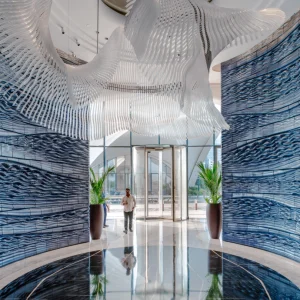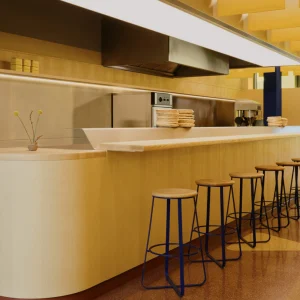SOME OF the most remarkable architectural achievements have emerged from difficult circumstances. When faced with challenging locations, architects are often compelled to innovate, creating designs that not only tackle constraints head on, but even transform them into defining features. At the Royal Institute of British Architects (RIBA), the exhibition Difficult Sites: Architecture Against The Odds presents 18 British projects that in different ways demonstrate the skill, ingenuity and creativity of architects in overcoming some of the most awkward and demanding conditions. From negotiating irregular-sized plots and difficult topography, to conservation considerations and zoning laws, architects are routinely called upon to surmount obstacles with groundbreaking solutions. As the exhibition’s diverse selection so ably illustrates, the difficulties of a site are not merely obstacles to be overcome but opportunities to reimagine what is possible in the built environment. Time and time again, creativity is shown to flourish under constraint as problems are transformed into triumphs of design.
 Archway Studios is a live-workspace that Undercurrent Architects squeezed into a constrained site beside and beneath a brick archway in a Victorian railway viaduct in south London. Image Credit: Undercurrent Architects
Archway Studios is a live-workspace that Undercurrent Architects squeezed into a constrained site beside and beneath a brick archway in a Victorian railway viaduct in south London. Image Credit: Undercurrent Architects
While the projects on display cover a good deal of the UK, a large proportion are London-based, where space is at a premium. This was especially true of the site of the London School of Economics’ Saw Swee Hock Student Centre (2012), designed by O’Donnell and Tuomey. The building’s sharp edges and irregular geometries reflect the architects’ ingenious solution to an extremely narrow and restrictive site set at the convergence of several medieval streets in central London. Indeed, urban environments frequently pose some of the toughest tests for architects, who have to grapple with unwieldy plots or carefully negotiate between the old and the new. A particularly impressive example is Archway Studios (2012), a live-workspace that Undercurrent Architects managed to squeeze into a severely constrained site beside and beneath a brick archway in a Victorian railway viaduct in south London. Among the building’s innovative design features is a ring of slender steel foils around its vaulted interior that isolate the property from the noise of trains, while the apertures of its slender Corten steel atrium are cleverly designed to allow daylight to penetrate deep inside the recessed interiors. The stunning Tardis-like property, which serves as both a family home and photography studio, was crowned House of the Year in the 2013 London Architecture Awards.
 Archway Studios is a live-workspace that Undercurrent Architects squeezed into a constrained site beside and beneath a brick archway in a Victorian railway viaduct in south London.
Archway Studios is a live-workspace that Undercurrent Architects squeezed into a constrained site beside and beneath a brick archway in a Victorian railway viaduct in south London.
When it comes to mass social housing, one of the most iconic solutions to the limitations of available sites in the English capital is Neave Brown’s Alexandra Road Estate (1978). Located in Camden and covering 6.47 hectares, this landmark of British modernist architecture combines low-rise terraced housing principles with high-density living to provide 520 homes for over 1,600 residents. The long and narrow strip of land posed significant challenges, especially as it borders the mainline railway to the north. Brown’s solution was an innovative eight-storey, concrete ziggurat structure that not only shielded the estate from the noise of passing trains but provided an antidote to the proliferation of high-rise tower blocks that were increasingly littering British city skylines. A series of stairways at the front of the development rise to maisonettes with private terraces, each connected to a pedestrian walkway below. Camden Council, under the leadership of Sydney Cook, championed the project as part of its commitment to progressive social housing. However, the ambitious design encountered several delays due to the difficult site conditions and complex construction methods (not least the logistical challenge of installing foundations next to working railway tracks), resulting in significant budget overruns. The final cost of £20.9m made it one of the most expensive social housing schemes in the UK. As a result of maintenance challenges, Alexandra Road fell into disrepair during the 1980s, but a resident-led campaign achieved Grade II-star listing for the estate in 1994. Today, it serves as a model for sustainable and community-centred housing in the urban environment.
 The site for Caruso St John’s Brick House is described by the practice as of almost insuperable difficulty
The site for Caruso St John’s Brick House is described by the practice as of almost insuperable difficulty
Natural landscapes bring their own set of hurdles for architects, especially if they are hard to access. Indeed, some sites are so remote that consideration must even be given to how construction materials will be delivered. Such was the case for Mary Arnold- Forster Architects, a studio working across rural locations in Scotland and the UK that in 2020 completed the cross-laminated timber house An Cala, at Nedd in the Scottish Highlands. The rugged, steep-sloping site, which overlooks Loch Nedd high up the west coast of Scotland, could only be reached via a steep and winding single track road that was unsuitable for large lorries. For the client, it was important that the building celebrate the natural beauty of the area while causing as little physical and visual disturbance as possible. The two-bedroom, single-storey house was therefore carefully oriented to sit between two outcrops to avoid any rock breaking, while support stilts raising it off the ground averted the need for any ground bearing slabs.
 An iconic solution to the limitations of available sites in London is Neave Brown’s Alexandra Road Estate. Image Credit: Eric Firley, Riba Collections
An iconic solution to the limitations of available sites in London is Neave Brown’s Alexandra Road Estate. Image Credit: Eric Firley, Riba Collections
Because of the access challenges – not to mention the extreme weather conditions in the Highlands – the structure was prefabricated by Carbon Dynamic, a pioneer in the development of sustainable and environmentally friendly, modular off-site construction. The size of the modules were determined by the type of vehicle that could reach the site from Inverness and, once delivered, the 13 sections were assembled in just four days. The house is divided into three interlinking pods, encompassing the main living space, en-suite master bedroom and guest bedroom. The exterior’s dark hues and minimalist design avoids competing with the dramatic landscape, while inside, the living and sleeping spaces are lined in pale timber. Designed with sustainability in mind, the house incorporates a rainwater harvesting system and high-efficiency heating system. With stunning views over the local landscape, it is an exemplary fusion of thoughtful design and environmental integration, feeling both contemporary and deeply connected to its surroundings.
 The Magna Science Adventure Centre, an educational visitor attraction in Rotherham, is an example of a redundant industrial site being skilfully transformed into a cultural destination
The Magna Science Adventure Centre, an educational visitor attraction in Rotherham, is an example of a redundant industrial site being skilfully transformed into a cultural destination
While the exhibition has its fair share of private homes (including a disused water tower in Norfolk converted into a luxury home by Tonkin Liu, and a rustic, late 19th-century Arts and Crafts cottage created by Ernest Gimson on a rocky Leicestershire hillside), there are also large-scale architectural projects such as Cornwall’s Eden Project, a major visitor attraction designed by Grimshaw Architects that combines science, art and sustainability. Opened in 2001, the sprawling complex features two huge enclosures consisting of interlinking domes that house thousands of plant species from around the globe. Each one replicates a natural environment: the Rainforest Biome, the largest indoor rainforest in the world, contains lush vegetation, waterfalls, and even a canopy walkway, while the Mediterranean Biome offers a tranquil environment of olive trees, citrus groves, and aromatic herbs.
 Knox Bhavan’s March House, along the Thames near Marlow
Knox Bhavan’s March House, along the Thames near Marlow
The carefully maintained ecosystems of the Eden Project thrive within a former disused china clay quarry, where shifting ground soil and crumbling chalk cliffs were among the challenges that Grimshaw had to overcome. With a brief to create the largest botanical garden in the world, the architects began work on the designs before the final ground conditions were fully known. This resulted in a flexible yet robust solution that could adapt to the highly unstable site. Indeed, the project’s iconic geodesic domes are an engineering marvel. Constructed using a framework of galvanised steel pipes, they are divided into 9m hexagonal modules and, instead of traditional glass, are fitted with cushions of lightweight, inflated transparent foil, which not only reduce weight but also allow the entire structure to remain completely free of internal supports. The design exemplifies forward-thinking architectural ingenuity, enabling the Eden Project to maintain its diverse ecosystems under one elegant, futuristic aesthetic. As part of the RIBA display, a simple sketch outlines the initial concept, while a detailed site model demonstrates how the differentsized domes were made to fit snuggly into the quarry. There is also a fascinating sectional model showing a portion of a geodesic biome and a site plan illustrating how the structures link together.
 A disused water tower in Norfolk was converted into a luxury home by Tonkin Liu
A disused water tower in Norfolk was converted into a luxury home by Tonkin Liu
Compelling models, photographs and drawings from RIBA’s collections as well as individual practices are seen at every turn in this exhibition. Among the highlights is a beautiful beechwood scale model of the new 27m-high Weston Tower at Westminster Abbey (2018), which was designed by Ptolemy Dean for a very restricted site squeezed between the south transept, King Henry VII’s Chapel and the Chapter House. Another large-scale model depicts Trafalgar Square in central London with the unrealised National Gallery extension proposed in 1984 by Ahrends Burton Koralek. The prominent glass and steel tower, which appears strikingly incongruous, was famously criticised by King Charles III, then the Prince of Wales, as being totally inappropriate. His view was echoed by the press, politicians and public alike, which led to planning being refused and the proposal being scrapped in favour of Venturi, Rauch and Scott Brown’s postmodern scheme, which echoes the main building’s neoclassical rhythms and forms but subtly undermines them with its bunched-up, concertina pilasters.
 The London School of Economics’ Saw Swee Hock Student Centre, designed by O’Donnell and Tuomey. Image Credit: Shutterstock Ron Elis
The London School of Economics’ Saw Swee Hock Student Centre, designed by O’Donnell and Tuomey. Image Credit: Shutterstock Ron Elis
Another fascinating exhibit is the 1957 presentation drawing by Basil Spence for the new Coventry Cathedral, showing his radically modern design rising from the remains of the medieval original, which had been destroyed in November 1940 during one of the most intensive bombing raids of the Second World War. Having stood for more than 500 years, the cathedral was completely burnt out, leaving only its tower, spire and outer walls standing. Spence won the competition to find an appropriate architectural solution to the highly sensitive site and his scheme looked to preserve as much of the original structure as possible, proposing that the ruins would act as a garden of remembrance and a symbolic entrance to the new building. Indeed, Spence’s grand design is a visual embodiment of the journey from sacrifice to the triumph of the Resurrection, its bold, modernist style effectively amplifying the message of renewal and hope for the future.
 The postmodern Sainsbury Wing of the National Gallery, by Venturi, Rauch and Scott Brown
The postmodern Sainsbury Wing of the National Gallery, by Venturi, Rauch and Scott Brown
 The new Coventry Cathedral, by Basil Spence, was a radically modern design rising from the remains of the medieval original, which had been destroyed in November 1940 during the Second World War. Having stood for more than 500 years, the cathedral was completely burnt out, leaving only its tower, spire and outer walls standing. Spence won the competition to find an appropriate architectural solution and his scheme looked to preserve as much of the original structure as possible, proposing that the ruins would act as a garden of remembrance and a symbolic entrance to the new building
The new Coventry Cathedral, by Basil Spence, was a radically modern design rising from the remains of the medieval original, which had been destroyed in November 1940 during the Second World War. Having stood for more than 500 years, the cathedral was completely burnt out, leaving only its tower, spire and outer walls standing. Spence won the competition to find an appropriate architectural solution and his scheme looked to preserve as much of the original structure as possible, proposing that the ruins would act as a garden of remembrance and a symbolic entrance to the new building
When Spence was working on his plans for the new Coventry Cathedral, there was little worry about height restrictions or zoning regulations. Conversely, restrictive planning conditions set by Camden Council presented a significant challenge to Colin St. John Wilson and MJ Long, the architects appointed in 1962 to design the new British Library in London. Initially proposed for a site opposite the British Museum, the library finally opened 30 years later in 1998 on a brownfield site once used as a railway goods yard near St. Pancras. The challenges here were manifold. The site, a narrow wedge, was constrained by two London Underground lines running underneath and stringent planning conditions that included a height limit and a requirement for public space at the Euston Road entrance. These restrictions forced much of the library underground, including its vast book depositories, which descend 24m and had to be carefully positioned to avoid the existing tube tunnels.
 Restrictive planning conditions set by Camden Council presented a significant challenge to Colin St. John Wilson and MJ Long, the architects appointed in 1962 to design the new British Library in London. Initially proposed for a site opposite the British Museum, the library finally opened 30 years later in 1998 on a brownfield site once used as a railway goods yard near St. Pancras
Restrictive planning conditions set by Camden Council presented a significant challenge to Colin St. John Wilson and MJ Long, the architects appointed in 1962 to design the new British Library in London. Initially proposed for a site opposite the British Museum, the library finally opened 30 years later in 1998 on a brownfield site once used as a railway goods yard near St. Pancras
 Cornwall’s Eden Project, a major visitor attraction designed by Grimshaw Architects, combines science, art and sustainability. Opened in 2001, the complex features two huge enclosures consisting of interlinking domes that house thousands of plant species from around the world. The carefully maintained ecosystems of the Eden Project thrive within a former disused china clay quarry, where shifting ground soil and crumbling chalk cliffs were among the challenges that Grimshaw had to overcome
Cornwall’s Eden Project, a major visitor attraction designed by Grimshaw Architects, combines science, art and sustainability. Opened in 2001, the complex features two huge enclosures consisting of interlinking domes that house thousands of plant species from around the world. The carefully maintained ecosystems of the Eden Project thrive within a former disused china clay quarry, where shifting ground soil and crumbling chalk cliffs were among the challenges that Grimshaw had to overcome
National projects often face difficult journeys, but the British Library’s was especially turbulent. Initially intended to be built in three phases in order to spread the cost over several years, the project saw its budget slashed in 1980 when the new Conservative government reduced its spending commitment from £22.5m to £9m across the first four years. Significant changes to the design were required and after more delays, disputes and political wrangling, the project was finally truncated at Phase One in 1988. To make matters worse, Camden Council insisted that the library frontage be set back and that its height not exceed 15m so as to preserve views of the adjacent Midland Grand Hotel, George Gilbert Scott’s Gothic masterpiece built in 1873. The library got there in the end, though not without suffering the injustice of being described by King Charles III as ‘a building suiting an academy for secret policemen’. A beautifully rendered coloured pencil illustration by Eric Winter depicts the smart-looking structure from Midland Road, showing it in relation to the nearby hotel. Though striking in their differences, the two buildings sit together amicably, thanks in large part to the fact that the library’s architects specified identical red bricks throughout, with over 11 million sourced from the same Peterborough brickworks used by Scott. Despite its fraught history, the British Library stands today as a modern landmark and, as with all of the brilliant projects showcased in this RIBA exhibition, reflects the extraordinary perseverance and resourcefulness of architects in the face of adversity.





